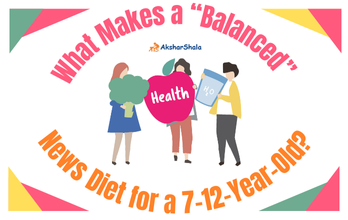
Find What You Need
Search courses, notes, videos, books & more…

What Makes a “Balanced” News Diet for a 7–12-Year-Old?
Why News for Kids Should Be Balanced
Just as you wouldn’t serve only dessert at dinner, you shouldn’t serve only one type of news to a child.
A healthy news mix helps:
Build curiosity about the world.
Develop empathy by showing differences. In contrast, objectives.
Encourage critical thinking—asking “why” and “how” instead of just “what happened.”
It's important to remember that too much heavy news (such as crime or disasters) can lead to anxiety, while an excess of entertainment news can result in a superficial understanding of the world. A balanced news diet is the key to avoiding these pitfalls and ensuring that children are not overwhelmed by the news they consume.
The “Balanced News Plate” for Kids
Think of it like a food plate—a mix of flavors keeps it healthy and exciting:
World & Local Events—Age-appropriate updates on significant events, explained simply.
Science & Nature—Space missions, new inventions, and animal discoveries.
Inspiring Stories—People who made a positive difference.
Arts, Sports & Culture – Creativity, teamwork, and cultural pride.
Problem-Solving News – Articles that talk about solutions, not just problems.
Parents: You Are the Key to Building a Balanced News Diet
A balanced news diet works best when parents are the “news chefs.” Here’s how:
Curate content: Pick sources that explain news for young minds—like children’s newspapers, Aksharshala’s Shouryagathayein, or kid-friendly news videos.
Co-watch and co-read: Discuss the story together. Ask, “What do you think about this?”
Balance the mood: If the news is heavy, follow up with something uplifting.
Encourage questions: Let curiosity lead the conversation.
Fact-check together: Show them how to verify from credible sources.
Aksharshala’s Kid-Friendly News Recommendations
We have a few golden rules when designing our children’s news section:
Simple Language, Strong Impact—No jargon, but rich in ideas.
Balanced Emotion—Mix serious with light-hearted stories.
Visual Aids – Infographics, cartoons, and photos to help understanding.
Interactive Engagement—Quizzes, polls, or “What would you do?” prompts.
For example, in our Shouryagathayein series, a story about a freedom fighter is paired with a fun fact sheet and a puzzle. This way, kids remember history and enjoy learning it.
Try This at Home: Build Your Weekly News Plate
Here’s a quick activity for your child:
Step 1: Draw a plate divided into five sections.
Step 2: Label them—World, Science, Inspiration, Culture, and Problem-Solving.
Step 3: Each day, add one news story in the correct section.
Step 4: At the end of the week, talk about which section had the most stories and which had the least.
This not only makes news more engaging but also teaches children to seek variety.
Final Thoughts
A balanced news diet for 7–12-year-olds isn’t about hiding the truth—it’s about serving the truth in portions they can digest. Just as healthy eating shapes the body, a balanced news diet shapes the mind, fostering curiosity, empathy, and critical thinking.
At Aksharshala, we’re committed to helping families raise informed, curious, and compassionate young citizens—one balanced news plate at a time.
For Parents: Check out Aksharshala’s upcoming “News for Young Minds” guide with curated stories, activities, and discussion prompts—designed to make news time a bonding time.
For Kids: Keep your curiosity hat on! The world is full of stories—some will make you think, some will make you smile, and some will inspire you to write your own. Stay curious and keep exploring!
